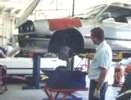
Bad News for Workers in HSE Hearing Protection Field Study
The Health and Safety Laboratory study, posted today by the Health and Safety Executive, included outdoor and indoor workers, laboratory measurements of real-world attenuation, and some premises visited without warning.
A new study conducted by the Health and Safety Executive's Health and Safety Laboratory finds big problems with hearing protection programs of employers whose premises the investigators visited. The problems will be familiar to hearing conservation professionals in this country: Workers often were overprotected, many employers made no attempt to measure noise levels and simply handed everyone the same protectors, training was uneven, none of the employers was aware noise cancellation and communication products are available, and even at sites where most workers effectively used protectors, one in seven employees did not wear any. Typically, those who did not said reduced audibility was the reason, according to the executive summary of the 74-page study, titled "Real world use and performance of hearing protection."
Its author is Liz Brueck, BSc, MIOA, of the laboratory. Twelve companies allowed on-site observers to check hearing protector use. The sites visited for the study included a manufacturer of vehicle components, a bottling plant, a motor vehicle repair shop, an ironwork restorer/manufacturer, printers, a candy factory, a sheet metal workshop, and a cement works.
The report makes seven recommendations:
- Make employers aware that hearing protection is not a simple or reliable solution and should not be the only solution considered for a noise problem.
- Ensure upper and lower sound levels for which a protector is likely to be suitable are listed on its packaging and with any advertising.
- List a maximum lifetime, in terms of approximate duration of use, for protectors because deterioration may not be apparent to the user.
- Make employers aware of potential fit problems with compressible foam ear plugs, which "are generally poorly fitted," the report says.
- Increase awareness of protectors that can assist audibility and communication.
- Make metal-traceable ear plugs available in a wider range of attenuation than is currently available.
- Provide clothing compatible with correct ear muff fitting for outdoor workers. When they wear muffs over conventional hats and hoods, the muffs do not provlde the intended attenuation, according to the report.